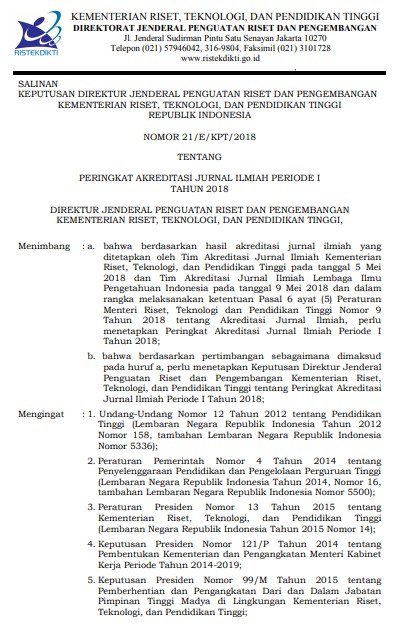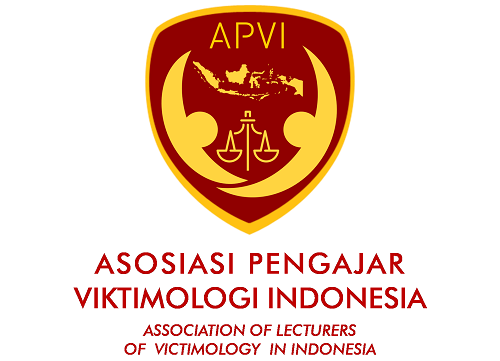The Effectiveness of Coaching Prisoners With The Therapeutic Community Method in The Cirebon Class IIA Narcotics Penitentiary
Abstract
Drug abuse is a significant problem, various rehabilitation efforts are carried out at the Cirebon Class IIA Narcotics Penitentiary, one of which is by using therapeutic communities to provide expectations of drug abuse inmates. The problems studied in this research are related to the rehabilitation of prisoners and their implications with the therapeutic community method at the Cirebon Class IIA Penitentiary. This research is empirical research that uses survey methods, observations, interviews, and literature studies. The data obtained are collected and analyzed qualitatively by analytical descriptive methods. The results showed that the therapeutic community can be implemented optimally but is still faced with the first problem therapeutic community has not been focused on the fundamentals of the resident's addiction and the second problem is that the resident is still faced with having to fight his mind with the effects of the relapse he feels.
Keywords: Coaching, Therapeutic community, Relapse.
Full Text:
PDF View
References
Abraham, C., & Shanley, A. (1997). Psikologi Sosial Untuk Keperawatan. Jakarta: EGC.
Adiyanti, M.G., & Yuniarti, K.W. (2015). Memaknai Kondisi Residen Therapeutic Community. Laporan Penelitian Fakultas Psikologi. Universitas Gajah Mada. 87-108.
Ardani, Irfan., Hari Cahyani, Heti Sri. (2019). Efektifitas Metode Therapeutic Community dalam Pencegahan Relapse Korban Penyalahgunaan Napza di Panti Sosial Pamardi Putra Galih Pakuan Bogor Tahun 2017. Buletin Penelitian Sistem Kesehatan. Vol. 22. No. 3. 184-191. http://dx.doi.org/10.22435/hsr.v22i3.1281.
Badan Narkotika Nasional, & LIPI. (2018). Executive Summary Survei Penyalahgunaan dan Peredaran Gelap Narkoba Tahun 2018. Jakarta: Badan Narkotika Nasional Indonesia.
Badan Narkotika Nasional Indonesia (BNN-Indonesia). (2018). Indonesia: Dalam Angka Tahun 2017. Jurnal Data Puslatdatin. 1-240.
Berglund, G.W., Bergmark, A., Björling, B., Grönbladh, L., Linberg, S., Oscarsson, L., Olsson, B., Segraseus, V., Stensmo, C. (1991). The Swede Project: Interaction between Treatment, Client Backgro,und and Outcome in A one Year Follow-up. Journal Substance Abuse Treatment. Vol. 2. No. 8. 161-169. https://doi.org/10.1016/0740-5472(91)90008-x.
Brabender, V.A., Falcon, A.E., Smolar, A.I. (2004). Essentials of Group Therapy. New Jersey: Jhon Willey & Sons, Inc.
Cohen, S., Kammarck, T., Mermelstein, R. (1983). A Global Measure of Perceived Stress. Journal of Health and Social Behavior. Vol. 24. No. 4. 385-396. https://doi.org/10.2307/2136404.
De Leon, G. (1986). The Therapeutic Community: Theory, Model, and Method. New York: Springer Publishing Inc.
De Leon, G. (1989). Psychopathology and Substance Abuse: what is being learned from research in therapeutic communities. Journal of Psychoactive Drugs. Vol. 21. No. 2. 177-188. https://doi.org/10.1080/02791072.1989.10472158.
De Leon, G., & Ziegenfuss, J. T. (2000). Therapeutic Community for Addictions: Reading in Theory, Research and Practice. New York: Springer Publishing Inc.
Fahrudin, A., & Nurdin, D. (2010). Coping Strategies and Relapse of Substance Abusers: A Case Study of the Therapeutic Community Program in Indonesia. Journal Asian Social Work and Policy Review. Vol. 4. No. 2. 98-117. https://doi.org/10.1111/j.1753-1411.2010.00040.x.
Firdaus, Insan. (2019). Peranan Pembimbing Kemasyarakatan Dalam Upaya Penanganan Overcrowded pada Lembaga Pemasyarakatan. Jurnal The Jure. Vol. 13. No. 3. 339-358. https://dx.doi/10.30641/kebijakan.2019.v13.339-358.
Galassi, A., Mpofu, E., Athanasou, J. (2015). Therapeutic Community Treatment of an Inmate Population with Substance Use Disorders: Post-Release Trends in Re-Arrest, Re-Incarceration, and Drug Misuse Relapse. International Journal of Environmental Research and Public Health. Vol. 12. No. 6. 7059-7072. https://doi.org/10.3390/ijerph120607059.
Hamja. (2015). Model Pembinaan Narapidana Berbasis Masyarakat (Community Based Correction) Dalam Sistem Peradilan Pidana. Jurnal Mimbar Hukum. Vol. 27. No. 3. 446-458. http://doi.org/10.22146/jmh.15882.
Hamja. (2019). Effectiveness of Mental Development of Prisoners in Cirebon Narcotics Prison Class IIA as A form of Correctional Purpose. Jurnal Dinamika Hukum. Vol. 19. No. 1. 133-151. http://doi.org/10.20884/1.jdh.2019.19.1.2066.
Hubbard, L.R. (2004). Criminon Indonesia. Los Angeles: Association For Better Living and Educational International.
Husak, Douglas N. (2004). Guns and Drugs: Case Studies on the Principled Limits of the Criminal Sanction. Jurnal Law and Philosophy. Vol. 23. No. 5. 437-493. http://www.jstor.org/stable/4150549.
Imron, M., A. (2013). Hubungan Fungsional Badan Narkotika Nasional dengan Lembaga Pemasyarakatan dalam Penanggulangan Narkotika di Lembaga Pemasyarakatan. Jurnal Ius. Vol. 1. No. 2. 327-345.
Johnson, K.W. Pan, Z., Young, L., Vanderhoff, J., Shamblen, S., Browne, T., Suresh, G. (2008). Therapeutic Community Drug Treatment Success in Peru: A Follow-up Outcome Study. Journal Substance Abuse: Treatment, Prevention, and Policy. Vol. 3. No. 26. 1-15. https://dx.doi.org/10.1186%2f1747-597x-3-26.
Johnson, K.W., Young, L., Shamblen, S., Suresh, G., Browne, T., Cookhare, K.W. (2012). Evaluation of the Therapeutic Community Treatment Model in Thailand: Policy Implications for Compulsory and Prison-Based Treatment. Journal Substance Use & Misuse. Vol. 47. No. 8-9. 899-909. https://doi.org/10.3109/10826084.2012.663279.
Kooyman, M. (1993). The Therapeutic Community for Addicts, Intimacy, Parent Involvements and Treatment Success. Lisse: Swets & Zeitlinger.
Lee, H., Shin, S.K., Park, S.Y. (2014). Effects of a Therapeutic Community on Korean Substance Abusers in Prison. Jurnal Social Service Research. Vol. 40. No. 4. 481-490. https://doi.org/10.1080/01488376.2014.922401.
Malivert, Fatseas, M. M., Denis, C., Langlios, E., Auriacombe, M. (2012). Effectiveness of Therapeutic Communities: A Systematic Review. Jurnal European Addiction Research. Vol. 18. No. 1. 1-11. https://doi.org/10.1159/000331007.
Maynard, A., & Richardson, G. (1994). Is the Treatment of Drug Addicts Cost-Effective? In Europe Against Drug Abuse. Journal Proceedings of the European Conference on Rehabilitation and Drug Policy. 97-103.
McCusker, J., Vickers-Lahiti, M., Stoddard, A., Hindin, R., Bigelow, C., Zorn, M., Garfield, F., Forst, R., Love, C., Lewis, B. (1995). The Effectiveness of Alternative Planned Durations of Residential Drug Abuse Treatment. American Journal of Public Health. Vol. 85. No. 10. 1426-1429. https://doi.org/10.2105/AJPH.85.10.1426.
Northam, J. C., & Magor-Blatch, L. E. (2016). Adolescent Therapeutic Community Treatment-an Australian Perspective. Jurnal Therapeutic Communities: The International Journal of Therapeutic Communities. Vol. 37. No. 4. 204-212.
Novitasari, D. (2017). Rehabilitasi Terhadap Anak Korban Penyalahgunaan Narkoba. Jurrnal Hukum Khaira Ummah. Vol. 12. No. 4. 917-926.
Orwat, J., Samet, J., Tompkins, H., Cheng, C. P., Dentato, M. P., Saitz, R. (2011). Factors Associated with Attendance in 12-step Groups (Alcoholics Anonymous/Narcotics Anonymous) Among Adults with Alcohol Problems Living with HIV/AIDS. Journal Drug and Alcohol Dependence. Vol. 113. No. 5. 165-171. https://doi.org/10.1016/j.drugalcdep.2010.07.021.
Ravndal, E., & Vaglum, P. (1991). Psychopathology and Substance Abuse as Predictor of Program Completion in a Therapeutic Community for Drug Abusers: A prospective study. Journal Acta Psychiatrica Scandinavica. Vol. 83. No. 3. 217-222. https://doi.org/10.1111/j.1600-0447.1991.tb05528.x.
Saefudin, Y., Raharjo, A., Budiono. (2017). Urgency of Integrated Assesment on Drugs Crime (A study in Purbalingga Regency). Jurnal Dinamika Hukum. Vol. 17. No. 1. 41-52. http://doi.org/10.20884/1.jdh.2017.71.1.808.
Sharifi, H., Kharaghani, R., Sigari, S., Emami, H., Sadr, M., Masjedi, M. R. (2012). Common Methods to Treat Addiction in Treatment-Rehabilitation Center in Tehran. Iranian Journal Public Health. Vol. 41. No. 4. 63-68.
Smith, J., M. & Estefan, A. (2014). Family Parenting Adolescence with Substance Abuse-Recovering the Mother’s Voice: A Narrative Literature Review. Journal of Family Nursing. Vol. 20. No. 4. 415-441.
Solinas, M., Thiriet, N., Chauvet, C., Jaber, M. (2010). Prevention and Treatment of Drug Addiction by Environmental Enrichment. Jurnal Progress in Neurobiology. Vol. 92. No. 4. 572-592. https://doi.org/10.1016/j.pneurobio.2010.08.002.
Soyez, V. (2004). The Influence of Social Networks on Retention In and Success After Therapeutic Community Treatment. Orthopedagogische Reeks Gent Dissertation. Vol. 16. 1-186.
Wayman, C. (2013). Group Versus Individual Therapy in Adolescent Substance Abuse Treatment: Finding Interventions That Work. Counselor Educations Master’s Theses. 1-152.
Whitesell, M., Bachand, A., Peel, J., & Brown, M. (2013). Familial, Social, and Individual Factors Contributing to Risk for Adolescent Substance Use. Journal of Addiction. 1-9. https://doi.org/10.1155/2013/579310.
Widyaningrum, Rachmawati. (2014). Komunikasi Therapuetik Konselor Adiksi Pada Korban Penyalahgunaan Narkoba di Rumah Palma Therapeutic Community Kabupaten Bandung Barat. Jurnal Kajian Komunikasi. Vol. 2. No. 2. 173-185. https://doi.org/10.24198/jkk.v2i2.7384.
Zimmer-Höfler, D., Dobler-Mikola, A., Uchtenhagen, A., Christen, S. (1994). Therapeutic Communities and Methadone Treatment in Follow-up Research in Europe Against Drug Abuse, Proceeding of the European Conference on Rehabilitation and Drug Policy. Stockholm Sweden: Swedish National Board on Health and Welfare.
DOI: http://dx.doi.org/10.20884/1.jdh.2022.22.1.2672
Refbacks
- There are currently no refbacks.
JURNAL DINAMIKA HUKUM Indexed by :
 | Jurnal Dinamika Hukum | |
| Faculty of Law, Universitas Jenderal Soedirman | Copyright of Jurnal Dinamika Hukum | |
| Yustisia IV Building, Law Journal Center | ISSN 2407-6562 (Online) ISSN 1410-0797 (Print) | |
| Purwokerto, Central Java, Indonesia, 53122 | JDH is licensed under a Creative Commons Attribution 4.0 International License | |






